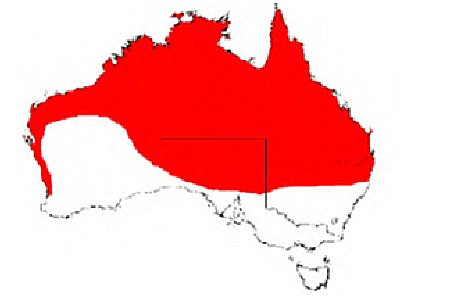Canine ehrlichiosis is a disease of dogs caused by infection with a bacterium called Ehrlichia canis. The bacterium is carried by ticks. In Australia, dogs can be infected with E.canis after being bitten by an infected brown dog tick.
The disease occurs in the northern regions of Western Australia and South Australia, all of the Northern Territory and north-western Queensland. People travelling with their dogs into areas where brown dog ticks are present (see the map below) need to be aware of the disease and know how to protect their dog.
- Be particularly vigilant when in tick-infested environments and where there are congregations of dogs which may be carrying ticks. This includes places where you may stop at, like fuel stations and caravan parks.
- Check your dog regularly for ticks.
- Run your fingers through your dog’s coat over their skin and feel for abnormal bumps. Pay particular attention to the head and neck, inside their ears, on their chest, between their toes and around their mouths and gums.
- Use a tick repellent product on all dogs. Repellent tick collars and spot-ons provide the best primary protection, in combination with tablets and chews registered for brown dog tick control. Your veterinarian can provide advice about appropriate product use and dose frequency.
- Treat confirmed or potentially infected dogs with registered systemic tick control products for life, even if no ticks are visible on the dog. This will help prevent the disease spreading to other regions.
- Seek advice from the relevant state veterinary authority before moving potentially infected dogs to other parts of Australia. Some states require pre-movement testing, whereas others place a biosecurity obligation on the person in charge of the dog.
Check state and territory movement conditions
Western Australia
E. canis movement conditions for dogs moving into or travelling within Western Australia have been removed. The Department of Primary Industries and Regional Development strongly encourages anyone moving a dog out of an area where E. canis is known to be active to ensure their dog is healthy and on an effective brown dog tick prevention and control program. DPIRD has further information about moving dogs into or within WA.
Queensland and New South Wales
Under Queensland’s General biosecurity obligation and the NSW General biosecurity duty, people moving dogs into these states must take reasonable and practical steps to prevent the introduction of E canis. These steps could include testing dogs prior to movement and only travelling with healthy dogs that are on an effective tick control program.
Find out more from the Queensland Department of Agriculture and Fisheries and the NSW Department of Primary Industries.
Tasmania
Tasmania requires dogs entering the state to be declared tick free on arrival. Find out more on the Biosecurity Tasmania website.
Other states and territories
- Northern Territory Department of Primary Industry and Resources
- Department of Primary Industries and Regions South Australia
- Agriculture Victoria
Resources
Download and print our free ehrlichiosis materials and spread the word to dog owners about the dangers of ehrlichiosis.

